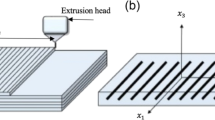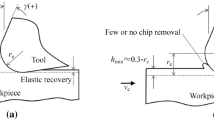Abstract
This paper presents a mathematical model for the geometric design of a custom-engineered form milling (CEFM) cutter and develops an accurate 3D surface-based generic definition of the form mill. The proposed geometric definition of the CEFM cutter is developed in terms of biparametric surface patches using newly defined 3D rotational angles rather than the conventional 2D angles. The non-uniform rational B-spline curve fairing and sweep surface approaches are used to design the cutting edge and flank surface, respectively, of the cutter. To validate the methodology, an interface is developed that converts the proposed 3D parametric definition of the cutter into an intermediate neutral CAD format and then renders the cutter model in any CAD modeling environment. The accuracy of the mathematical model is verified by evaluating the deviation plot between the surfaces of the proposed cutter model and the surfaces developed using digitized data of an existing actual CEFM cutter. The satisfactory comparison verifies the shape design methodology for custom cutters presented in this paper. The method described here offers a simple and intuitive way of generating shape design of custom cutters for possible use in machining process simulations, finite element analysis, and other applications.
Similar content being viewed by others
References
Wilson FW (1987) ASTME: fundamentals of tool design. Prentice Hall, New Jersey
Drodza TJ, Wick C (1983) Machining, tool and manufacturing engineers handbook, vol I. Society of Manufacturing Engineers, Dearborn
Vijayaraghavan A, Dornfeld DA (2007) Automated drill modeling for drilling process simulation. J Comp and Infor Sci Engg 7:276–282
Tandon P, Khan MR (2009) Three dimensional modeling and finite element simulation of a generic end mill. Comput-Aided Des 41(2):106–114
Mortenson ME (1985) Geometric modeling. Wiley, New York
Rogers DF, Adams JA (1990) Mathematical elements of computer graphics. McGraw-Hill, New York
Tandon P, Gupta P, Dhande SG (2003) Geometric modeling of single point cutting tool surfaces. Int J Adv Manuf Tech 22(1–2):101–111
Tandon P, Gupta P, Dhande SG (2005) Geometric modeling of end mills. Computer-Aided Design and Appli 2(1–4):57–66
Kuo HC, Wu LJ (2001) A study on the evaluation of a model of the precise outside of the roller nest mill cutter. J Mat Proc Tech 117:178–182
Hsieh JM, Tsai YC (2006) Geometric modeling and grinder design for toroid-cone shaped cutters. Int J Adv Manuf Tech 29:912–921
Radzevich SP (2007) A novel method for mathematical modeling of a form-cutting-tool of the optimum design. Appl Math Model 31:2639–2654
Wang GC, Fuh KH, Yan BH (2007) Geometry design model of a precise form milling cutter based on the machining characteristics. Int J Adv Manuf Tech 34:1072–1087
Radzevich SP (2007) A novel design of cylindrical hob for machining of precision involute gears. ASME J Mech Des 129:334–345
Hsieh JK, Tseng HC, Chang SL (2009) A novel hob cutter design for the manufacture of spur-typed cutters. J Mat Proc Tech 209:847–855
Vasilis D, Nectarios V, Aristomenis A (2007) Advanced computer aided design simulation of gear hobbing by means of three-dimensional kinematics modeling. ASME J Manuf Sci Engg 129:911–918
Farin G (2002) Curves and surfaces for computer-aided geometric design—a practical guide, 5th edn. Academic, San Diego
IGES 5.3 (1996) US Product Data Association. IGES/PDES Organization, USA
Author information
Authors and Affiliations
Corresponding author
Rights and permissions
About this article
Cite this article
Khan, M.R., Tandon, P. Mathematical modeling for the design of a generic custom-engineered form mill. Int J Adv Manuf Technol 54, 139–148 (2011). https://doi.org/10.1007/s00170-010-2936-4
Received:
Accepted:
Published:
Issue Date:
DOI: https://doi.org/10.1007/s00170-010-2936-4




